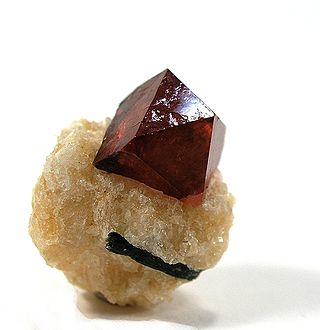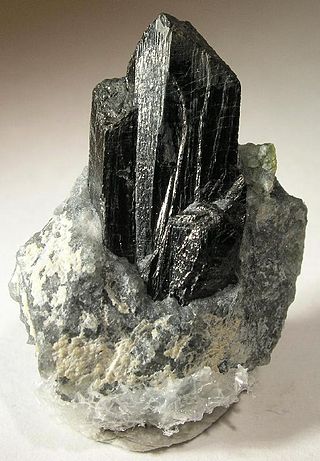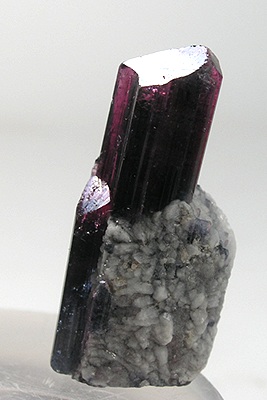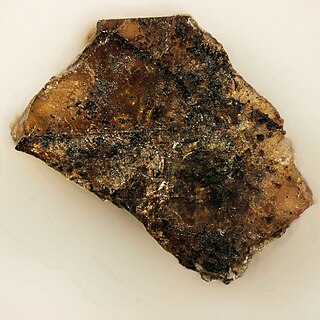
Zircon is a mineral belonging to the group of nesosilicates and is a source of the metal zirconium. Its chemical name is zirconium(IV) silicate, and its corresponding chemical formula is ZrSiO4. An empirical formula showing some of the range of substitution in zircon is (Zr1–y, REEy)(SiO4)1–x(OH)4x–y. Zircon precipitates from silicate melts and has relatively high concentrations of high field strength incompatible elements. For example, hafnium is almost always present in quantities ranging from 1 to 4%. The crystal structure of zircon is tetragonal crystal system. The natural color of zircon varies between colorless, yellow-golden, red, brown, blue, and green.

Baddeleyite is a rare zirconium oxide mineral (ZrO2 or zirconia), occurring in a variety of monoclinic prismatic crystal forms. It is transparent to translucent, has high indices of refraction, and ranges from colorless to yellow, green, and dark brown. See etymology below.
Zircophyllite is a complex mineral, formula (K,Na)3(Mn,Fe)2+7(Zr,Ti,Nb)2Si8O24(OH,F)7. It crystallizes in the triclinic - pinacoidal crystal class as dark brown to black micaceous plates. It has perfect 001 cleavage, a Mohs hardness of 4 to 4.5 and a specific gravity of 3.34. Its indices of refraction are nα=1.708 nβ=1.738 nγ=1.747 and it has a 2V optical angle of 62°.

Agrellite (NaCa2Si4O10F) is a rare triclinic inosilicate mineral with four-periodic single chains of silica tetrahedra.

The mineral zektzerite is a member of the tuhualite group and was first found in 1966 by Seattle mineralogist Benjamin Bartlett "Bart" Cannon. It was discovered in the Willow creek basin below Silver Star mountain in miarolitic cavities within the alkaline arfvedsonite granite phase of the Golden Horn batholith, Okanogan County, Washington. It is named for Jack Zektzer, mathematician and mineral collector of Seattle, Washington.
Hafnium silicate is the hafnium(IV) salt of silicic acid with the chemical formula of HfSiO4.

Fluor-liddicoatite is a rare member of the tourmaline group of minerals, elbaite subgroup, and the theoretical calcium endmember of the elbaite-fluor-liddicoatite series; the pure end-member has not yet been found in nature. Fluor-liddicoatite is indistinguishable from elbaite by X-ray diffraction techniques. It forms a series with elbaite and probably also with olenite. Liddiocoatite is currently a non-approved mineral name, but Aurisicchio et al. (1999) and Breaks et al. (2008) found OH-dominant species. Formulae are

Vlasovite is a rare inosilicate (chain silicate) mineral with sodium and zirconium, with the chemical formula Na2ZrSi4O11. It was discovered in 1961 at Vavnbed Mountain in the Lovozero Massif, in the Northern Region of Russia. The researchers who first identified it, R P Tikhonenkova and M E Kazakova, named it for Kuzma Aleksevich Vlasov (1905–1964), a Russian mineralogist and geochemist who studied the Lovozero massif, and who was the founder of the Institute of Mineralogy, Geochemistry, and Crystal Chemistry of Rare Elements, Moscow, Russia.
Gugiaite is a melilite mineral, named for the Chinese village of Gugia where it was first discovered. Its chemical formula is Ca2BeSi2O7. It occurs mostly in skarns with melanite adjacent to an alkali syenite and has no economic value. Its crystals are small tetragonal tablets with vitreous luster and perfect cleavage. It is colorless and transparent with a density of three. The mineral belongs to space group P-421m and is strongly piezoelectric.
Carbokentbrooksite is a very rare mineral of the eudialyte group, with formula (Na,□)12(Na,Ce)3Ca6Mn3Zr3NbSiO(Si9O27)2(Si3O9)2(OH)3(CO3).H2O. The original formula was extended to show the presence of cyclic silicate groups and silicon at the M4 site, according to the nomenclature of eudialyte group. Carbokenbrooksite characterizes in being carbonate-rich (the other eudialyte-group species with essential carbonate are zirsilite-(Ce), golyshevite, and mogovidite). It is also sodium rich, being sodium equivalent of zirsilite-(Ce), with which it is intimately associated.

Zirsilite-(Ce) is a very rare mineral of the eudialyte group, with formula (Na,□)12(Ce,Na)3Ca6Mn3Zr3NbSi(Si9O27)2(Si3O9)2O(OH)3(CO3)·H2O. The original formula was extended to show the presence of cyclic silicate groups and the presence of silicon at the M4 site, according to the nomenclature of the eudialyte group.according to the nomenclature of eudialyte group. Zirsilite-(Ce) differs from carbokentbrooksite in cerium-dominance over sodium only. Both minerals are intimately associated. The only other currently known representative of the eudialyte group having rare earth elements (in particular cerium, as suggested by the "-Ce)" Levinson suffix in the name) in dominance is johnsenite-(Ce).
Davinciite is a very rare mineral of the eudialyte group, with the simplified formula Na12K3Ca6Fe32+Zr3(Si26O73OH)Cl2. The formula given does not show the presence of cyclic silicate groups. The mineral was named after Leonardo da Vinci to refer to the atypical geometrical forms he tended to use, compared by the authors of the mineral description to the atypical (not ideally centrosymmetrical) geometry of the Davinciite structure. The other quite atypical feature of Davinciite is its lavender colour, while the typical eudialyte is rather pink or red.

Georgbarsanovite is a very rare mineral of the eudialyte group, formerly known under unaccepted name as barsanovite, with formula Na12(Mn,Sr,REE)3Ca6Fe32+Zr3NbSi(Si3O9)2(Si9O27)2O4Cl2·H2O. The original formula was extended to show the presence of cyclic silicate groups and domination of silicon at the M4 site. "REE", standing for rare earth elements, are dominated by cerium. Georgbarsanovite characterizes in dominance of manganese at the N4 site. It also differs from most other accepted group representatives in its colour. The mineral was found in nepheline pegmatite nearby Petrelius river, Khibiny massif, Kola Peninsula, Russia. It is named after Russian mineralogist Georg Barsanov.

Manganokhomyakovite is a very rare mineral of the eudialyte group, with the chemical formula Na12Sr3Ca6Mn3Zr3WSi(Si9O27)2(Si3O9)2O(O,OH,H2O)3(OH,Cl)2. This formula is in extended form, to show the presence of cyclic silicate groups and domination of silicon at the M4 site, basing on the nomenclature of the eudialyte group. Some niobium substitutes for tungsten in khomyakovite. As suggested by its name, manganokhomyakovite is a manganese-analogue of khomyakovite, the latter being more rare. The two minerals are the only group representatives, beside taseqite, with species-defining strontium, although many other members display strontium diadochy. Manganokhomyakovite is the third eudialyte-group mineral with essential tungsten.

Kentbrooksite is a moderately rare mineral of the eudialyte group, with chemical formula (Na,REE)15(Ca,REE)6Mn3Zr3NbSi[(Si9O27)2(Si3O9)2O2]F2·2H2O. This extended formula shows the presence of cyclic silicate groups and dominance of Si at the M4 site, according to the nomenclature of the eudialyte group. The characteristic features of kentbrooksite, that make it different from eudialyte are: (1) dominancy of fluorine (the only currently known example among the whole group), (2) dominancy of manganese, and (3) dominancy of niobium. Trace hafnium and magnesium are also reported. Kentbrooksite is relatively common when compared to most other species of the group.

Manganoeudialyte is an moderately rare mineral of the eudialyte group, with formula Na14Ca6Mn3Zr3Si2[Si24O72(OH)2]Cl2·4H2O. The formula given is one of the forms that can be given, based on the originally reported one, and shows dominance of silicon at both the M3 and M4 sites. As suggested by its name, it is the manganese-analogue of eudialyte.
Mogovidite is a very rare mineral of the eudialyte group, with formula Na9(Ca,Na)6Ca6(Fe3+,Fe2+)2Zr3[]Si(Si9O27)2(Si3O9)2(CO3)(OH,H2O)4. The formula given is based on the original one but extended to show the presence of cyclic silicate groups. It is similar to feklichevite, differing from it in the presence of essential vacancies and carbonate group. Another specific feature is the dominance of ferric iron - a feature shared with other eudialyte-group members, including feklichevite, fengchengite, golyshevite and ikranite. Similarly to golyshevite, it is calcium-dominant, however on three sites: M(1), N(3) and N(4). It has a molecular mass of 3,066.24 gm.
Voronkovite is a very rare mineral of the eudialyte group with the chemical formula Na15(Na,Ca,Ce)3(Mn,Ca)3Fe3Zr3Si2Si24O72(OH,O)4Cl·H2O. The formula is based on the simplified original one; it does not show the presence of cyclic silicate groups, but two M3- and M4-site silicon atoms are shown separately (basing on the nomenclature of the eudialyte group). Voronkovite has lowered symmetry (space group R3, instead of more specific for the group R3m one), similarly to some other eudialyte-group members: aqualite, labyrinthite, oneillite and raslakite. The specific feature of voronkovite is, among others, strong enrichment in sodium.

Rastsveatevite is a rare mineral of the eudialyte group with the chemical formula Na27K8Ca12Fe3Zr6Si4[Si3O9]4[Si9O27]4(O,OH,H2O)6Cl2. Its structure is modular. It is only the third member of the group after andrianovite and davinciite with essential (site-dominating) potassium. Potassium and sodium enter both N4 and M2 sites. The mineral is named after Russian crystallographer Ramiza K. Rastsvetaeva.

Béhierite is a very rare mineral, a natural tantalum borate of the formula (Ta,Nb)BO4. Béhierite is also one of the most simple tantalum minerals. It contains simple tetrahedral borate anions, instead of more common among minerals, planar BO3 groups. It forms a solid solution with its niobium-analogue, schiavinatoite. Both have zircon-type structure (tetragonal, space group I41/amd) and are found in pegmatites. Béhierite and holtite are minerals with essential tantalum and boron.













